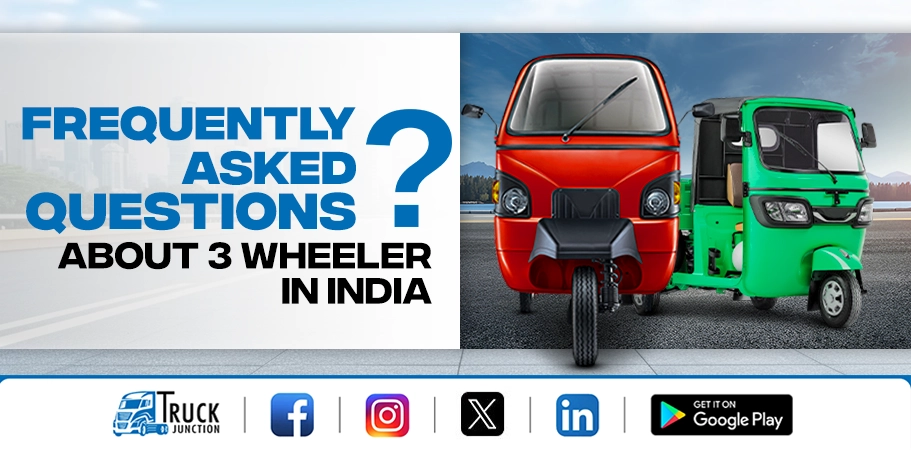Frequently Asked Questions About 3 Wheeler in India

In India, auto rickshaws and tuk-tuks hold a very important position in the three-wheeler segment. The popular 3 wheeler models are known for their affordability, maneuverability in traffic, and ability to navigate very narrow streets with easy turns. The 3 wheeler price in India ranges from Rs. 0.58 Lakh to Rs. 5.60 Lakh (ex-showroom). Furthermore, they also run on diesel, petrol, CNG, LPG, and even electric-powered 3 Wheeler in India.
In this blog, we will answer some of the most frequent questions about three wheelers in India. Buying one or simply learning more about them – these FAQs will certainly be very helpful for you.
Read Also: Top 5 CNG Three Wheeler for 2024
FAQs About 3 Wheeler In India
1. Which are India’s top 3 wheeler brands?
Ans: The top three-wheeler brands in India are Bajaj Auto, Piaggio Vehicles, and Mahindra Electric. Their vehicles have reliability, innovation, and wide range of networks all over the country; hence, they easily head this category for three-wheelers.
2. What is the Three Wheeler price range in India?
Ans: The three wheelers price in India ranges from Rs 0.58 lakh to Rs 5.60 lakh. There are several models and configurations, such as passenger carriers, goods carriers, electric versions, etc. The cost differs with different brands, engine types, features, and fuel options.
3. Which is the most affordable three-wheeler model in India?
Ans: The most affordable three wheeler in India is the SN Solar Energy New Passenger Electric Rickshaw. This popular electric model price ranges between Rs 0.58 lakh and Rs 0.63 lakh.
4. Which is the most expensive three wheeler model in India?
Ans: The most expensive three-wheeler model is the OSM Vicktor electric rickshaw. Its price ranges between Rs 5.00 lakh to Rs 5.60 lakh.
Read Also: Top 10 Three Wheeler Truck Models in India
5. How fuel-efficient are three-wheelers across India?
Ans: They are quite fuel-efficient, normally ranging between 20 and 35 kilometers per liter. The actual mileage depends on the model and the type of engine. Moreover, Diesel and CNG versions are equally available and run much more economically than their petrol-version counterparts, making them very pocket-friendly for daily running.
6. Do three-wheelers e rickshaw need any licence to drive?
Ans: Yes, an e-rickshaw does require a valid driving license for it to be legally capable of running on roads. To this end, one needs to get a specific three-wheeler license to guarantee his qualification regarding both safety and operation standards. This licensing system shall go side by side with training and testing to determine the capability of the driver to drive the vehicle on public roads safely.
7. What are some of the advantages of three-wheelers in India?
Ans: Three-wheelers in India present quite a few obvious advantages as a means of transport: they are economical, fuel-saving, and easy to drive, specially in crowded places. They come in compact sizes; hence, they should be quite suitable for short trips or even running urban commutes. Additionally, they have dual uses for passenger and freight transports, and many small business owners can afford them.
8. What is the load carrying capacity of commercial three-wheelers in India?
Ans: Commercial three-wheelers in India typically have a load capacity that lies between 450 kg and 1,000 kg. This again is model-dependent and has manufacturers coming into the picture. These vehicles are often used by business owners to move goods and for other local delivery purposes, including small-scale logistics.
Read Also: Top 6 Electric Three Wheeler Manufacturers In India
9. How is the three-wheeler market expected to grow in India?
Ans: Growing urbanization in India will also act as a booster for the three-wheeler market. Furthermore, rising demand for low-cost transportation and government incentives for electric vehicles are some other factors that would bring more growth to the market. The market is increasingly shifting towards electric three-wheelers—driven by green concerns and policy impetus—contributing to its robust growth outlook.
10. What are the various types of 3-wheelers available in India?
Ans: Now, there are different varieties of three wheelers in India—from passenger autos to freight-carrying and electric variants. While the former carries people, the latter moves freight or goods. Electric three-wheelers, on the other hand, offer an eco-friendly alternative to them. Each of these types caters to different needs—from moving in urban towns to commercial transport.
11. Are 3 wheelers good for business in India?
Ans: Yes, three wheelers are good for business in India. They are inexpensive and versatile; thus, they can be used for most commercial purposes that require delivering goods, providing transport services, or even traversing narrow streets. Due to their low-cost and efficiency in operation, they find a place in the fleet of many small businesspeople and entrepreneurs.
12. What could be the maintenance cost of running a three-wheeler?
Ans: The cost of maintenance for three-wheelers includes regular servicing, battery replacement, and minor repairs. The monthly expenditure comes to about Rs 1,000 to Rs 2,000, a rough estimate. Batteries are replaced every 6 months to a year at a cost ranging from Rs 10,000 to Rs 20,000.
Conclusion
3 wheelers are compact in size, very affordable, and have low operating costs, thus making them perfect for transportation. The 3 wheeler market has some good future growth prospects, particularly because the new electric 3 wheelers have been augmented by government incentives recently. Leading brands like Bajaj and TVS have continued to come up with models that have considerable reliability at economical prices, thus meeting the varied requirements of Indian consumers.
Related Blogs
Best Piaggio 3 Wheeler Cargo Models In India
Greaves Eltra Cargo Three-Wheeler



